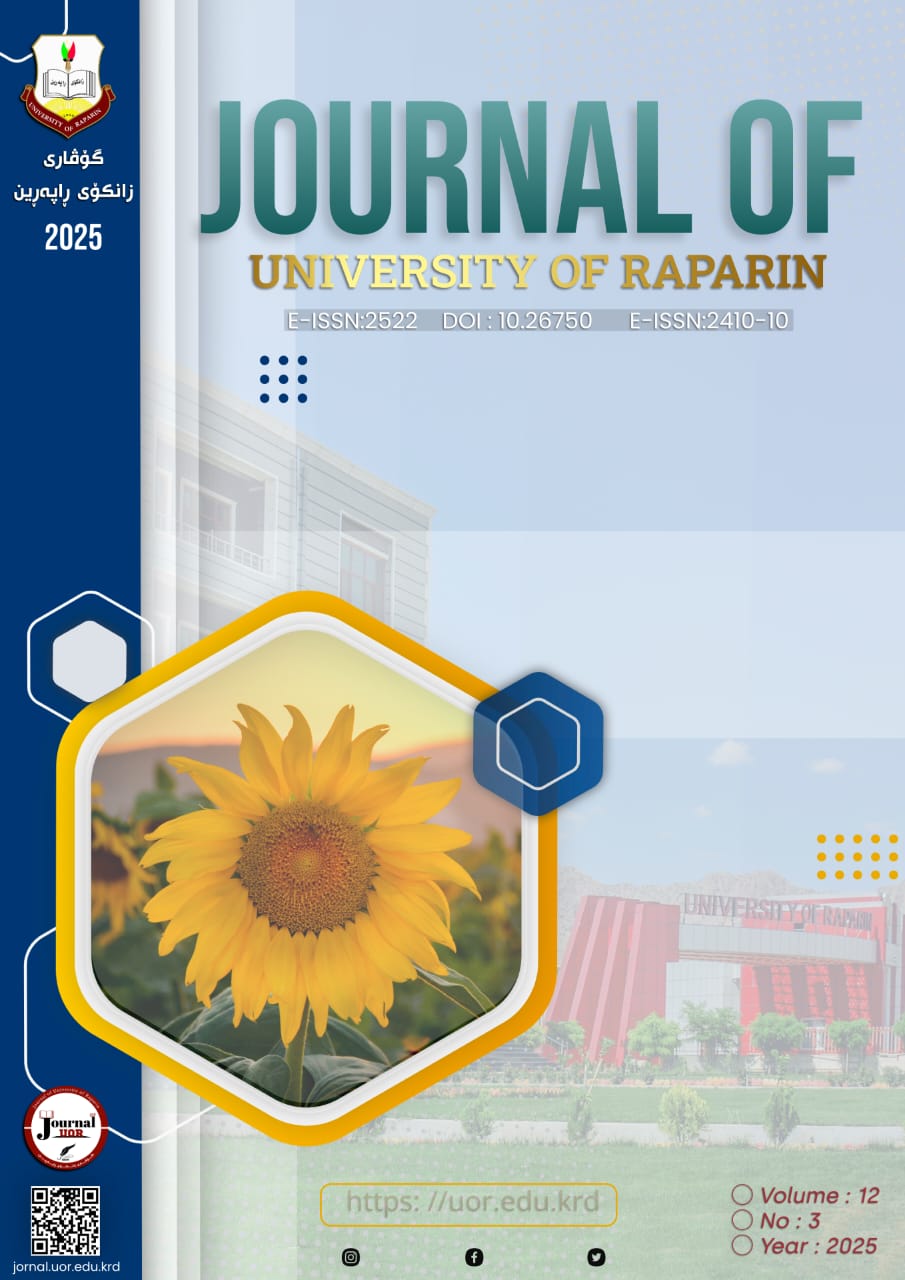Abstract
The Position of Head is an essential topic in Kurdish language phonology. This research attempts to determine the position of the verb head at the level of words, according to the metrical phonology theory. One syllable among a chain of connected syllables is more prominent than the adjacent syllables. In order to determine the verb head, we need to find out the syllable in the foot which bears the stress.
The fundamental questions of this research are: Is the verb Head in the metrical foot located to the right or the left of the foot? Which type of structure is the verb foot? These questions will be answered through analyzing samples of metrical feet presented using the metrical grid.
This research, reached the conclusion that the position of the verb head, and the type of verb foot -Badini dialect can be analysed via metrical phonology. Furthermore, the main and secondary stresses in the foot can be predicted by applying some rules. Depending on the collected data, it appeared that all syllables in Kurdish can be stress-bearers; hence, it is not easy to determine the position of the main stress. Consequently, the position of the main stress in the verb foot determines the Head of the verb. It can be stated that feet are bisyllabic in Kurdish, and that the first syllable is more prominent than the other one. In other words, the verb Head lies on the left side of the foot when written in International Phonetic Alphabet.
References
ئەمین، شلێر نایف، (٢٠١٨) ˈدەستنیشانکرنا سەرەى د هەڤالناڤێ لێکدایداˈ ، گۆڤارا زانستێن مرۆڤایەتى یا زانکۆیا زاخۆ، ژمارە (٣)، پەربەند (٦)، ل ٦٧٢-٦٨٢https://doi.org/10.26436/hjuoz.2018.6.3.116 .
ئەمین، وریا عومەر، (٢٠٠٩) ئاسۆیەکی تری زمانەوانی، بەرگی یەکەم، چاپی دوەم، هەولێر.
ئیبراهیم، هاوسەر نەوزاد فەقێ، (٢٠٢٢) دەنگسازى بەرهەمهێنان لە نێوان دەنگسازیى کێشناسى و دەنگسازیى کەرتە دەنگییە خودکارییەکاندا، نامەى دکتورا، کۆلیژى پەروەردە، زانکۆى ڕاپەڕین.
حەسەن، رەحمان ئیسماعیل، (١٩٩٨) پەیڕەوی فۆنیمە ناکەرتییەکان لە زمانی کوردی دا، نامی دکتورا، کولیژى پەروەردە- ئیبن رشد- زانکۆی بەغدا.
سەبری، شێرزاد و نەجمەدین، عەبدولسەلام، (٢٠١٩) فۆنۆلۆجى، چاپا ئێکێ، چاپخانەیا هیڤى- هەولێر.
غەریب، دڵشاد محەمەد، (٢٠١٩) هێز و ئەکسێنت لە شێوەزارى کەرکوکدا، نامەى دکتۆرا، کۆلیژى زمان، زانکۆى سلێمانى، سلێمانى.
فەتاح، محەمەد مەعروف، (٢٠١٠) لێکۆڵینەوە زمانەوانییەکان، کۆکردنەوە و ئامادەکردنى خۆشناو، شێروان حسێن و قادر، شێروان میرزا، چاپى یەکەم، چاپخانەى رۆژهەڵات (هەولێر).
محەمەد، کەسەر یاسین، (٢٠٢٣) فۆنۆلۆجییا بەرهەمهێنانێ یا نەڕاستەهێلى د زمانێ کوردیدا، چاپا ئێکێ، وەشانخانا پەرتوکخانا بەهدینان.
موسا، عەبدولوەهاب خالید، (٢٠٠٩) هێز و ئاوازە لە دیالێکتی کوردیی ژورودا، کتێبخانەی گشتی هەولێر، کوردستان.
وەیس، غازی فاتح، (١٩٨٤) فونەتیک، چاپی یەکەم، چاپخانەی الادیب البغدادی.
ژێدەر ب زمانێ عەرەبى:
بوعناني، مصطفى، (٢٠١٠) في الصوتیات العربیة و الغربیة ابعاد التصنیف الفونیتیقي و نماذج التنظیر الفونولوجي، عالم الکتب الحدیث، اربد-الاردن.
السغروشني ، ادريس، (١٩٨٧) مدخل للصواتة التوليدية، دار التوبقال للنشر.
Ahmad, A.M.R, (1986). The phonemic system of modern standard Kurdish. University of Michigan.
Al-Abdely, A., (2011). ‘Stress Patterns in an Iraqi Arabic Variant: a Metrical Approach’. Al-Anbar Journal of Education, 5, pp.379-402.
DOI:10.37654/aujll.2011.64152.
Al-Hindawi, D.F.H. and Al-Aadili, N.M. (2018), The Basic Tenets of Generative Phonology, University of Babylon. Journal of Education and practice, 10.
Chomsky, N . and. Halle,M. (1968) The Sound Pattern of English, The Mit Press Cambredge, Massachustts London,ED: 1991.
Fattah,M.M, (1997). A Generative Grammar of Kurdish , PhD thesis, Faculty of Humanities (FGw),Research conducted at: Universiteit van Amsterdam.
Jacques, D. (2014). Generative and non-linear phonology. Routledge.
Hamid,T.S. (2016). The prosodic phonology of Central Kurdish .Doctoral dissertation, Newcastle University.
Hasan, A. M. (2016), ˈ The phonological word and stress shift in northern kurmanji Kurdish ˈ European Journal of Scientific Research, September Vol-12. No-26.ISSN. pp 370-398. DOI: https://doi.org/10.19044/esj.2016.v12n26p370
Hayes, B., (1995). Metrical stress theory: Principles and case studies. University of Chicago Press.
Katamba, F., (1989). An introduction to phonology (Vol. 48). London: Longman.
McCarus,E.N. (1958), A Kurdish Grammear Descriptive analysis of the A Kurdish of Sulaimaniya, Iraq. New York: American Coincil of Learned Societies.
McCarthy, J.J., (1982). Nonlinear Phonology: an overview. University of Massachusetts, Linguistics Department Faculty Publication Series, p.50.
Nespor, M. and Vogel, I.B., (1986). Prosodic Phonology.-Dordrecht: Foris.-227 p.
Van Der Hulst, H. and Smith, N. eds., (1982). The structure of phonological representations (Vol. 2). Dordrecht: Foris. part1.

This work is licensed under a Creative Commons Attribution-NonCommercial-NoDerivatives 4.0 International License.
Copyright (c) 2025 Journal of University of Raparin

